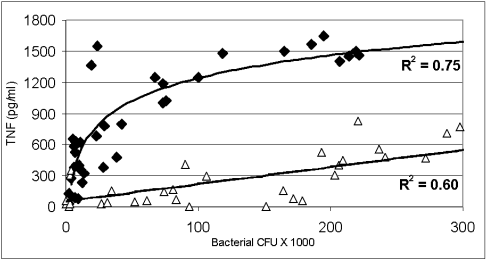# 108115 Abstract ID: 108115 Cholangitis: Bacterial Virulence Factors That Facilitate Cholangiovenous Reflux and TNFa Production
Lygia Stewart, Adair L Oesterle, J Mcleod Griffiss, Gary A Jarvis, Lawrence W Way, San Francisco, CA
PURPOSE: Our previous work has shown biliary bacteria produce slime and possess P1-pili. Serious biliary infections were caused by Gram-negative bacteria killed by complement, and associated with increased TNFa production with sera (in-vitro model of cultured monocytes). These data suggested a role for cytokine production in biliary sepsis. The current study examined bacterial virulence factors associated with cholangiovenous reflux and TNFa production in rats. METHODS: 20 biliary bacterial species, from patients with biliary infections, with a cross-section of virulence factors (slime production, complement sensitivity) were studied. Saline with or without 107 bacteria/ml was injected retrograde into the CBD of rats at a pressure of 30 mm Hg. Vena cava blood was obtained for culture 5 min after infusion, and for TNFa assay 60 minutes after infusion. 2-11 experiments were done for each bacterial species. RESULTS: Magnitude of slime production correlated inversely with bacterial cholangiovenous reflux. Average bacterial colony-forming units (CFU) were 1.41 X 105, 7.5 X 104, or 2.1 X 103 for bacteria with slime production 0-10, 11-99, or >100 respectively (P<0.0001, ANOVA). Blood bacterial CFU was greater for bacteria resistant to complement-killing versus those killed by complement, 1.15 x 105 vs 3.8 X 104, (P=0.001, t-test). But, TNFa production was greater for bacteria killed by complement (figure). TNFa production versus bacterial reflux followed a logarithmic curve (R2=0.75) for bacteria killed by complement (solid diamonds), while the function was linear (R5=0.59) for bacteria resistant to complement killing (open triangles). CONCLUSIONS: These data demonstrate the multifaceted nature of biliary bacterial virulence. While slime production was crucial for colonization, high levels inhibited reflux into the systemic circulation. Complement-killing cleared bacteria from the circulation, but it was associated with increased TNFa production, which can lead to sepsis. The most virulent bacteria (from patients with sepsis) made less slime, were killed by complement but had significant cholangiovenous reflux, and were associated with increased TNFa production. These findings help to explain why some bacterial species colonize but do not cause severe illness while others produce sepsis.

|
 500 Cummings Center
500 Cummings Center +1 978-927-8330
+1 978-927-8330
 +1 978-524-0461
+1 978-524-0461